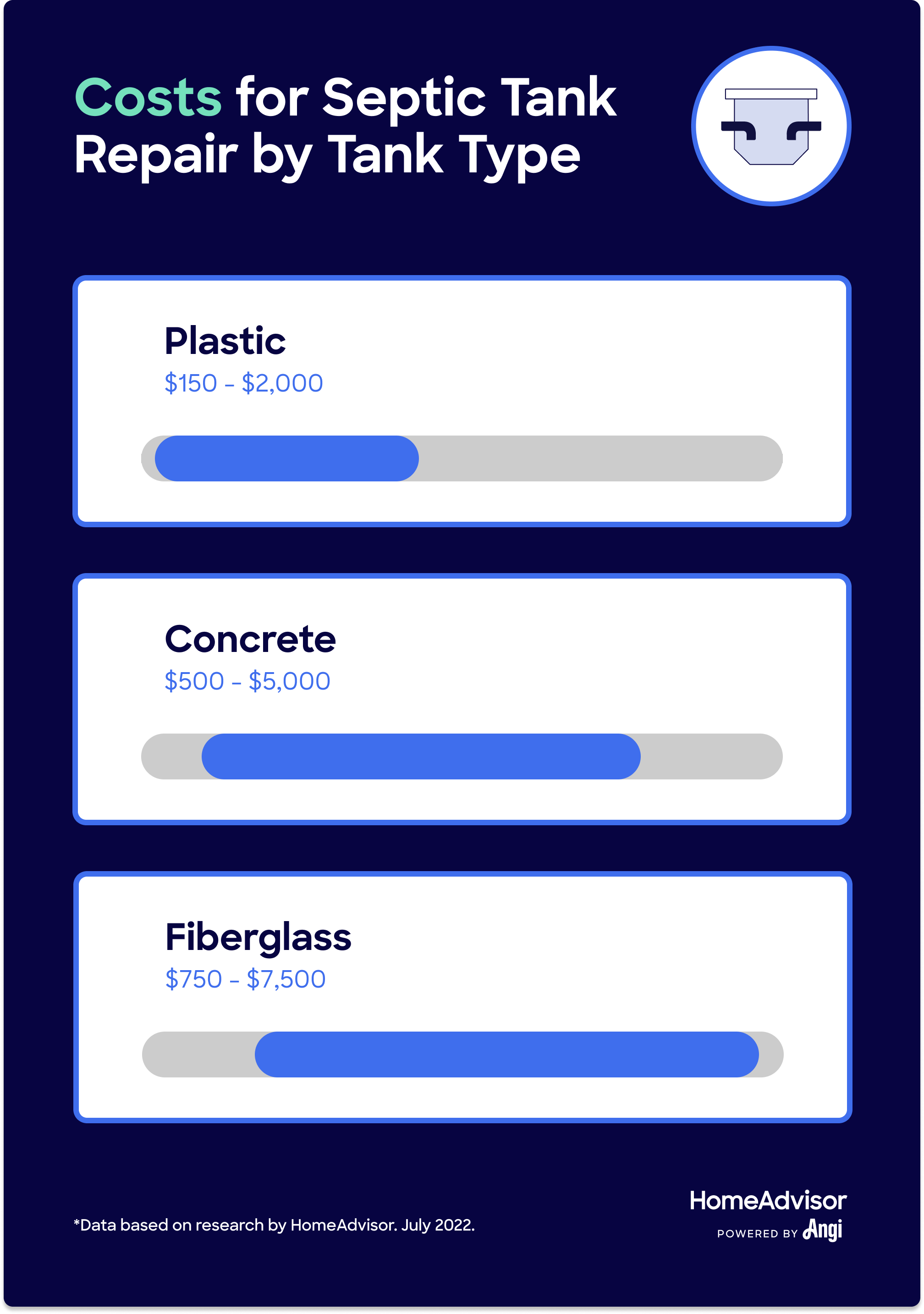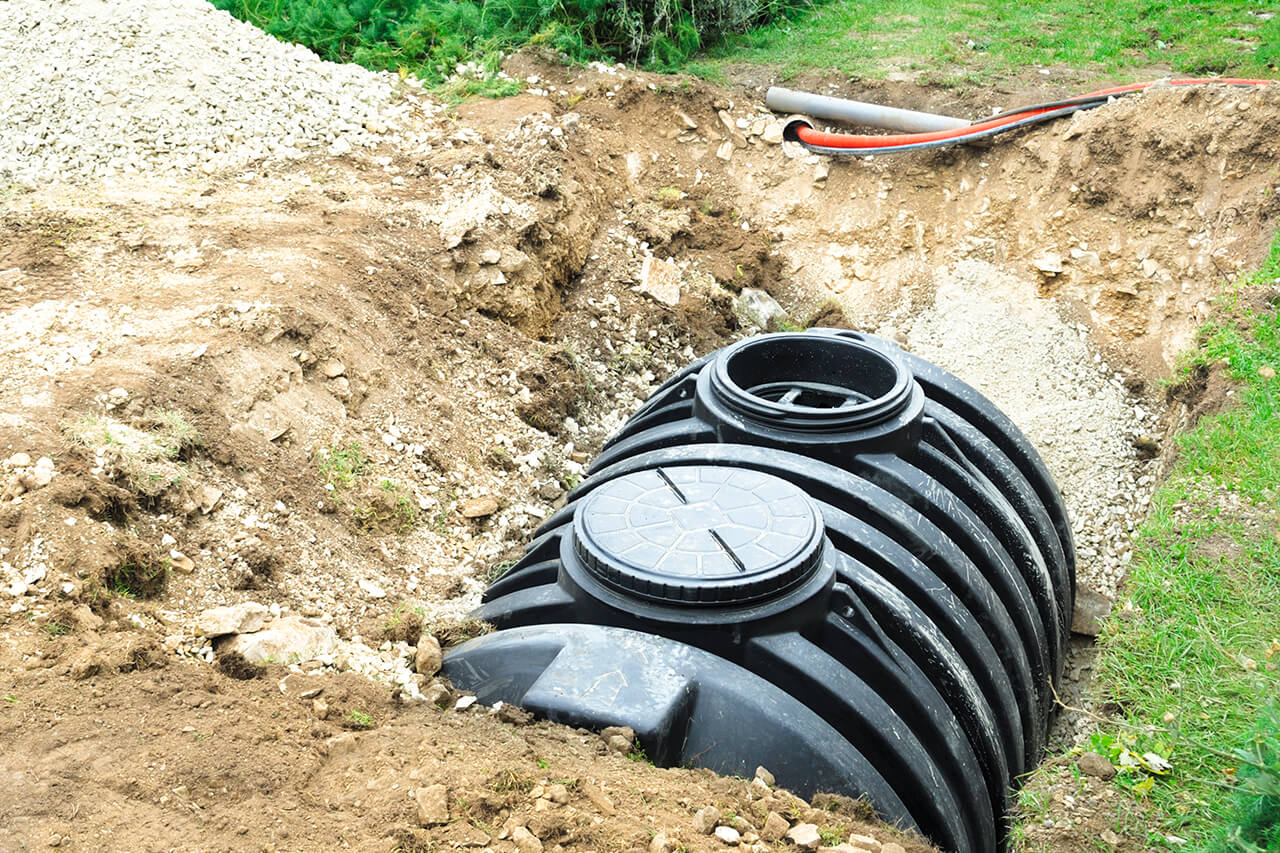How Much Does Septic Tank Repair Cost?
Typical Range:
$630 - $3,033
Typical Range:
$630 - $3,033
Cost data is based on actual project costs as reported by 1,710 HomeAdvisor members. Embed this data
.
.
.
.
.
.
.
.
.
.
.
.
.
.
.
.
.
.
.
.
.
.
.
.
.
.
.
.
.
.
•
•
•
•
Updated April 18, 2024
Reviewed by Jeff Botelho, Licensed Journeyman Plumber.DIY septic repairs can be dangerous and lead to costly mistakes, while professionals guarantee their work and offer maintenance options.
The average repair costs for a septic system range from $150 to $20,000, depending on the part and material.
Septic repair costs are influenced by the part being repaired, the system's material (plastic, concrete, or fiberglass), insurance coverage, and maintenance frequency.
Septic tank repairs involve materials like plastic, concrete, and fiberglass.
Signs your septic tank needs repair include frequent pipe back-ups, sewage-like smells, bright green grass, and puddles near your leach field.
Regular septic tank maintenance helps homeowners detect potential repairs early, prevents clogs, and ensures the system's longevity.
Highlights were summarized from this existing cost guide text using automation technology and were thoroughly reviewed for accuracy by HomeAdvisor Editor Ryan Noonan.
On average, septic tank repairs cost $1,830, or between $630 and $3,033. However, major repairs can run $6,000 or more. If you need to call in a tech to diagnose the issue, pay a service fee of $100 to $300 for their recommendations.
Let's calculate cost data for you. Where are you located?
Where are you located?
| National Average | $1,830 |
| Typical Range | $630 - $3,033 |
| Low End - High End | $170 - $6,500 |
Cost data is based on actual project costs as reported by 1,710 HomeAdvisor members.
| Repair Type | Cost |
|---|---|
| Baffle | $300-$900 |
| Add bacteria* | $400-$600 |
| Pump Repair | $250-$400 |
| Filter Replacement | $200-$300 |
| Leach Field Repair & Replacement | $2,000-$20,000 |
| Line Repair | $1,100-$4,200 |
| Tank Repair | $500-$10,000 |
*Homeowners can easily do this themselves by flushing products like RidX and Bio-Clean down the toilet for about $25.
Repairing a baffle costs $300 to $900, depending on how hard it is to access. The baffle helps prevent buildup in the pipes that connect to the tank.
Replacing bacteria in an aerobic system costs $400 to $600. You might need to add bacteria if the system has sat unused for a while. You can also buy over-the-counter products like RidX and Bio-Clean for about $25 that flush down the toilet.
You’ll pay about $250 to $400 to repair your septic pump. If the pump is beyond repair, a replacement costs $1,000 or more. Typical repairs include fixing issues stemming from the electrical system, a lack of proper maintenance, and physical damage (such as a vehicle driving over it).
We also recommend checking your filters for blockages or general wear and tear when repairing your pump.
A septic tank filter replacement ranges from $200 to $300. New, working filters help prevent clogs since they filter solid substances from entering the leach field. Clean waste water is better for the environment and can help your septic system last longer.
If you need to address a faulting leach field, budget $2,000 to $20,000. The leach field filters and disperses waste from the septic tank—a malfunctioning drain field indicates a pending septic system failure. Common causes of improper drainage include putting chemicals and grease down your drains, significant water runoff after heavy rains or snow, and leaking toilets and drains.
Regular septic tank maintenance helps homeowners can help prevent clogs and keep the layers inside the tank at reasonable levels. Still, leach fields won’t last forever. The average lifespan of leach fields is 15 to 25 years.
A broken pipe will run about $600 on average. A cracked or broken lateral line can range from $1,500 to $5,000. To avoid pipe damage, don’t park heavy machinery or vehicles over your drain field.
A septic tank wall repair averages $500 to $4,000. The damage is usually cracks or holes that lead to leakage. Experts can fill these cracks to restore the tank wall. In severe cases, concrete tank walls can soften and collapse, requiring total replacement.
The distribution box, also called the D-box, costs $500 to $1,500 to replace. Its job is to distribute the wastewater into the leach field evenly. Clogs or damage can alter the flow of water and flood the field.
If your lid is damaged, you’ll need to replace it for $150 to $500. The lid prevents debris from entering the tank and keeps gases and smells inside the tank.
There are three types of tanks: plastic, concrete, and fiberglass. Plastic tanks are more affordable but susceptible to damage. Concrete tanks will withstand environmental changes but are more expensive to buy and install. Depending on your tank’s material, repairs will range from $150 to $7,500.
Plastic septic tank repairs are usually the most affordable and range from $150 to $2,000, including labor. These tanks are watertight and are less likely to corrode or rust. Because plastic is flexible, they’re less prone to cracking—a common septic tank repair.
Concrete tank repairs cost $500 to $5,000. These tank types are heavy and long-lasting. But if your cement tank is damaged, it isn’t as easy to repair. Plus, concrete tanks corrode as they age, so you’ll need to be diligent about septic tank inspections.
Fiberglass tanks cost $750 to $7,500 to repair. These tanks typically stand up better to rust and cracks, but they’re lightweight, so you must take care not to damage them during installation.
There are a few different factors to consider when estimating repair costs. In particular, check your insurance and home warranty to see if your coverage will pay for the repairs.
Some septic system repairs are covered by home insurance policies. Check your policy to determine your coverage. Typically, they’ll cover damage caused by unexpected events but not issues stemming from normal wear and tear or lack of maintenance.
Many warranties cover septic tank systems. Depending on your coverage, you can expect to pay $35 to $125 for a service call.
Tank removal can cost $3,000 to $10,000. The price will depend on the size and type of tank, its condition, and accessibility.
You can expect a new septic system to last 20 to 30 years. To ensure its longevity, make sure to conduct routine maintenance.
Regular septic tank maintenance helps homeowners detect potential repairs at the first signs of damage to prevent unnecessary and costly repairs.
In an emergency, tank pumping costs can skyrocket rapidly. Adding products such as Rid-X can help the naturally occurring bacteria in your tank break down solid waste, preventing clogs and backups that can require an emergency pump-out.
A septic system inspection costs $250 to $400. A tech will check your pipes, tank, pump, and leach field. Some septic companies include this as part of their annual maintenance services.
If your pro recommends a camera inspection to get accurate visuals of hard-to-access parts of your system, budget about $900 for the service.
One-time septic tank pumping costs $290 and $550 on average. It’s best to pump it every three to five years. Most services also refer to tank pumping as tank cleaning, but they are not the same. Pumping requires a hose to grab liquid and any solids or sludge floating on the top of the tank. Cleaning drains all of the water and cleans any debris stuck to the bottom of the tank.
With the exception of bacteria maintenance, we don’t recommend DIY-ing any kind of septic tank cleaning or pumping. It’s best to let a pro navigate their heavy machinery and care for your system properly.
Hire a local septic tank cleaning company yearly. This prevents scum and sludge buildup and provides an opportunity to inspect the system for potential issues.
If you need to replace your system because it’s beyond repair, you can expect the cost of a septic system to range between $3,000 to $25,000, depending on the type and whether you need a leach field. The layout of your property and personal preferences will help you choose the right system.
A new anaerobic system will cost you $3,000 to $8,000. This is the most common system—it uses anaerobic bacteria, which don’t need oxygen, to break down the waste in the tank.
Aerobic systems use oxygen-loving aerobic bacteria to break down the waste in the tank. A new system costs $10,000 to $20,000 and switching from anaerobic to aerobic costs $5,000 to $10,000.
The most expensive septic system is the mound system. It uses a sand mound for a drain field, which makes it best suited for homes with high water tables or shallow bedrock. This system costs $10,000 to $20,000.
You can expect to pay $3,500 to $10,000 for a conventional septic system, which utilizes soil absorption trenches to treat the wastewater.
Chambered systems use perforated chambers around pipes and cost $5,000 to $12,000. It’s more fragile than other types of septic systems.
While it’s definitely possible to do some repairs to your own septic system, why would you want to? It’s dirty and dangerous work that requires an intricate understanding of the system’s makeup. Improperly installed systems can lead to leach field failure, a fix that could cost you as much as $20,000.
In contrast, a reputable septic system repair professional will:
Guarantee their work
Give you options for maintenance to keep future repairs at bay
Complete the job correctly and quickly
The septic tank—a watertight box made from concrete, plastic, or reinforced fiberglass—is the part of the system that holds and disposes of household waste. When waste enters the tank, organic material floats to the water's surface inside the tank. Bacteria turns it into a liquid and leaves solid material to fall to the bottom of the tank and form a layer of sludge. Then, the leftover water moves to a separate absorption area in the yard.
A septic tank lasts about 30 to 30 years or longer with proper maintenance.
Leach field failure happens when the tank, pump, or other subsystem isn’t maintained properly. Get a yearly cleaning and inspection by a professional to avoid failure.
Anything from age to environmental factors can cause a leach field to fail. The most common reason for leach field failure is system overload. Hydraulic overload in a leach field occurs when too much water is directed to the tank. Spacing out large dishwasher and laundry loads is advised for this reason.
Some signs your septic tank needs repair include:
Sewage-like smells coming from your fixtures
Frequent pipe back-us
Puddles in your yard and near your leach field
Bright green or spongy grass
The best way to avoid the need for repairs is to get an annual inspection and have the tank pumped every three to five years. However, how often you pump depends on the system’s age, size, and the number of people in your home.
Here are additional tips to avoid repairs:
Don’t throw anything besides toilet paper down your toilet
Use drain filters to catch hair in sinks and tubs
Avoid draining your laundry water or dishwater into the septic system
Don’t dump oil or grease down the drain

